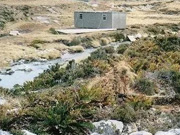

V. Main Measures to Cope with Nuclear Accidents
By referring the advanced international standards and drawing on worldwide mature experience, China has defined working measures to control, mitigate and cope with nuclear accidents commensurate with its national conditions and actual situation of nuclear energy development.
Implementing the defense-in-depth concept. Five lines of defense have been set up under which the nuclear emergency preparedness threshold is moved ahead and multiple barriers are installed to strengthen nuclear safety, prevent accidents and mitigate the consequences of an accident. The five lines of defense are: First, the quality of design, manufacturing, construction and operation shall be assured to prevent deviation from normal operation; second, operation procedures and operation technical specifications shall be rigorously followed and observed to ensure that each nuclear generating unit is operated within the defined safety range, any deviations therefrom are detected and corrected in a timely manner, and any abnormal operation is controlled to prevent it from evolving into an accident; third, in case a deviation fails to be corrected in a timely manner, plant safety and protection systems shall be automatically activated upon occurrence of an accident within the design datum, and emergency operations shall be organized to prevent the situation deteriorating; fourth, in case an accident fails to be controlled effectively, accident handling procedures shall be activated with the accident management strategy enforced to ensure that the containment shall remain intact and no radioactive substances are released into the environment; and fifth, in the event of failure of the above-mentioned lines of defense, off-site emergency actions shall be immediately activated in an effort to minimize any impact from the accident on the public or the environment. Meanwhile, multiple physical barriers shall be set up to ensure that multiple lines of defense are in place to prevent and control release of radioactive substances into the environment.
Exercising a tiered response scheme. The level of a nuclear accident shall be determined in accordance with the nature and seriousness of the accident and scope of effect from radiation, based on the International Nuclear and Radiological Event Scale (INES) guidelines of the International Atomic Energy Agency. The nuclear emergency preparedness condition is divided into Emergency Standby, Building Emergency, On-Site Emergency and Off-Site Emergency, which respectively correspond to Level IV response, Level III response, Level II response and Level I response. The first three levels of response mainly focus on the organization and implementation of emergency actions within the site. Off-Site Emergency shall be announced with its corresponding Level I response activated upon occurrence of release or possible release of a large quantity of radioactive substances into the environment in which accident consequences have crossed boundaries of the site, with the possibility of seriously jeopardizing public health and environmental safety.
Deploying actions of response. Every level of nuclear emergency organization shall implement the following response actions in whole or in part depending upon the nature and seriousness of the accident:
- Mitigating and controlling the accident in a timely manner. A professional force, equipment and supplies shall be thrown into immediate engineering emergency measures to mitigate and control any accident in an attempt to bring the relevant nuclear installation back to a safe condition while preventing or minimizing the release of radioactive substances into the environment.
- Conducting radiation monitoring and consequence assessment. Radiation monitoring shall be conducted at the site of the accident and areas affected and doses possibly absorbed by personnel shall be measured. Observation/surveillance and forecast on meteorological, hydrological, geological and seismic impacts shall be provided on a real-time basis. The accident conditions shall be diagnosed and substances released shall be analyzed to determine the accident evolution trend, evaluate radiation consequences and define the areas affected.
- Organizing personnel to implement emergency protection actions. If radioactive isotope of iodine has already been released or may be released arising from an accident, a professional team shall organize the public within a given area to take stable iodine pills to minimize radiation exposure to the thyroid gland. The people in the affected area shall be duly organized to take emergency protection measures deemed necessary, including hiding, evacuating, seeking temporary shelter or permanently moving out in order to prevent or minimize injuries from radiation exposure. Psychological assistance shall be provided in a timely manner to minimize social anxiety and panic.
- Arranging decontamination and medical treatment. Professionals shall be dispatched to remove or minimize radioactive pollution affecting people, equipment, premises and the environment. A nuclear emergency preparedness medical rescue force shall be organized to perform medical diagnoses, case identification and medical treatment, including on-site first-aid treatment, local hospital treatment and backup professional treatment.
- Controlling access passages and ports. Zones shall be demarcated according to the areas affected and strict control shall be enforced over the passage of people, vehicles, equipment and supplies in and out of the designated passages. People, vehicles, cargo containers, goods, travelers' belongings and parcels moving in or out of the border checkpoints shall be screened for radiation detection and control.
- Strengthening market supervision and regulation. Necessities shall be subject to market supervision and regulation in a timely manner in line with the supply of market and the public psych in the areas affected. Manufacturing, processing, circulation and consumption of contaminated food and drinking water shall be banned or limited, so as to prevent or minimize the intake of radioactive substances.
- Maintaining social order. Illegal or criminal acts, such as spreading rumors to create panic, shall be dealt with rigorously. Additional makeshift police posts shall be established to reinforce security patrols in important locations such as settlement sites and storage places for rescue supplies. Security for important premises such as the site of the nuclear accident shall be enhanced, and traffic control in the surrounding areas shall be properly coordinated according to actual needs.
- Releasing accurate official information. Accurate and official information shall be duly published to the public by the central, provincial (regional or municipal) governments and operators of nuclear installations in accordance with International Atomic Energy Agency (IAEA) practice, and the laws and regulations of China to ensure that information with respect to nuclear accident status, effects on the public and individual protection measures shall be disclosed to the public in an open, transparent and timely manner.
- Doing well in notifying the international community and requesting for help. Notification shall be given to the international community in accordance with the Convention on Early Notification of a Nuclear Accident of the IAEA. Request for assistance shall be made to the IAEA and the world community in accordance with the Convention on Assistance in the Case of a Nuclear Accident or Radiological Emergency of the IAEA, depending upon the actual situation.
Establishing a robust system of technical standards for national nuclear emergency preparedness. A complete system of technical standards for national nuclear emergency preparedness shall be established, and it covers the standards for classification of nuclear power plant emergency planning zones, nuclear accidents and emergency status, implementation of emergency protection actions, and definition of emergency intervention principles and levels of intervention, so as to provide a primary technical guideline for the implementation of nuclear emergency preparedness and response.
Strengthening emergency on-duty system. An emergency on-duty system shall be established to ensure that each level of nuclear emergency organization stays on-duty 24 hours a day. National contact points for nuclear emergency preparedness under the national nuclear accident emergency office shall be on duty for nuclear emergency preparedness to collect information about domestic nuclear installations and keep the IAEA updated.
 |  |
Day|Week

 Beautiful Chinese tennis player Wang Qiang goes viral online
Beautiful Chinese tennis player Wang Qiang goes viral online Chinese pole dancing master opens class in Tianjin
Chinese pole dancing master opens class in Tianjin The most beautiful town of snow in China
The most beautiful town of snow in China SWAT members hold romantic wedding in E China
SWAT members hold romantic wedding in E China Breathtaking scenery and simple lifestyle in Hainan
Breathtaking scenery and simple lifestyle in Hainan Finding sexiest underwear supermodels
Finding sexiest underwear supermodels Top 10 ancient pagodas in China
Top 10 ancient pagodas in China Chinese version of Victoria's Secret Show held in Hunan
Chinese version of Victoria's Secret Show held in Hunan Can you find out the sniper hiding in camouflage?
Can you find out the sniper hiding in camouflage? Spectacular rockets launch scenes
Spectacular rockets launch scenes